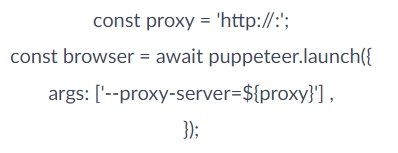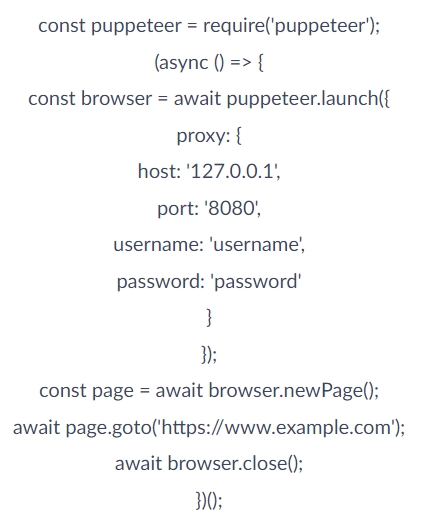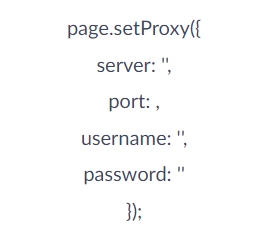How to set up mobile proxies in Puppeteer: a sequence of actions
The article content
- Top puppeteer practices: a brief introduction
- Tools worth integrating puppeteer with
- The most common problems that can be encountered when working with puppeteer
- Why it is worth organizing work with puppeteer via a mobile proxy
- The sequence of actions for connecting mobile proxies to the puppeteer library
- Summing up

The Puppeteer library is a functional, reliable and easy-to-use solution that provides comprehensive management of all browsers running on Chromium engines, including the extremely popular Google Chrome, Microsoft Edge and other solutions. This Internet scraping service is capable of programmatically managing Chrome and launching it directly from its own code. This is what turned it into a fairly universal tool capable of comprehensively solving a wide range of problems and simulating a huge number of very real browsing scenarios. Thanks to this, you will be able to ultimately develop the most correct strategy for subsequent actions.
In today's review, we will dwell in more detail on what opportunities the use of the Puppeteer service will provide you in practice. We will tell you what tools it can be integrated with. We will also highlight a number of problems that you, as a user of this application, may encounter in practice and simple ways to eliminate them. We will tell you what advantages you will receive if you connect mobile proxy servers to Puppeteer and describe how to perform these tasks in the Python programming language. The information provided will allow you to perform all these activities as quickly and correctly as possible, avoiding the most common mistakes. More details about what Puppeteer is, its functionality, advantages and disadvantages, as well as detailed instructions for creating a parser can be found here.
TOP Puppeteer practices: a brief introduction
During its existence on the market, Puppeteer has already proven itself to be a fairly powerful and functional tool. But still, it is necessary to understand it in detail in order to use all the possibilities to the maximum. And here are a number of general recommendations that everyone who is just starting to work with this tool should know.
From the main aspects characteristic of effective interaction with Puppeteer, we highlight:
- Constantly use asynchronicity. This means that you need to work with the tool in asynchronous mode all the time, using async/await.
- To ensure that all events are synchronized as correctly as possible and the first time, use waits.
- All tasks should be completed using the await command. This is the most correct approach.
These three very simple rules can greatly simplify your work with the tool, as well as minimize the errors that you may encounter in practice.
When working with Puppeteer, you may notice that the tool consumes quite impressive resources when performing certain tasks. It is in your interests to optimize its performance by organizing effective capacity management. And here, too, there are several simple recommendations:
- To free up additional resources for Puppeteer, close your Internet pages and the browser as a whole.
- Regularly monitor errors and fix them. This is what will prevent service failures, thereby ensuring high stability indicators.
- Forget about classic delay methods, including setTimeout or sleep. Today, they have been replaced by a solution such as the wait function. It is already built into Puppeteer by default. By the way, this is the company's own development.
- If you encounter the need to run scripts without connecting to the classic browser interface, feel free to switch to headless browser that is, to headless mode.
- To emulate certain network conditions, it is optimal to use a method such as page.setOfflineMode.
- To optimize the load and significantly reduce it, reduce the number of requests being processed.
- The best solution for monitoring how the scripts you run are executed, identifying even minor errors that are difficult to notice with the naked eye, is to use logs. Keep these records to monitor your entire process literally in real time.
We hope that you will use these recommendations to optimize your work with the Puppeteer service and ensure its stable operation even under increased loads.
Tools worth integrating Puppeteer with
In order to provide yourself with the widest possible opportunities when working with the Puppeteer service, you can easily integrate it with other software solutions, such as text frameworks, popular and in-demand development tools today. Among the most popular and widely used options, we highlight:
- Jest. This is a fairly popular framework today, which already has built-in support for Puppeteer. This combination is worth using at the UI testing stage. You will immediately notice how convenient and fast this process has become.
- WebdriverIO. This is a framework designed for automatic testing. Puppeteer support is also provided by default, in particular when working with Chrome.
- Mocha. One of the most flexible frameworks. It is intended for working with text content. In particular, through such integration, you can form text scripts as easily and simply as possible.
- TestCafe. With this tool, you can organize the most functional testing of various Internet applications. But if you additionally integrate it with Puppeteer, you can provide fairly broad coverage.
- GitLab CI. This is a continuous integration system. If necessary, you can also integrate it with Puppeteer in order to subsequently use it in text scripts.
- Jenkins. One of the most popular continuous integration systems today. If you use it together with the Puppeteer library, you can automate all the tests that you perform in CI/CD processes.
- Allure. Quite an interesting framework, developed specifically for generating bright, rich test reports. It also provides for joint work with Puppeteer.
- Lighthouse. This is a tool created specifically for performing performance tests. If you integrate it with Puppeteer, you will be able to automate the entire process of analyzing Internet applications, which will significantly reduce the time allocated for their testing.
That is, using this library in practice, you will be able to perform comprehensive automation of testing almost all web and mobile software products without exception, as well as the web scraping process itself.
The most common problems that can be encountered when working with Puppeteer
Forewarned is forearmed. This is the rule that works in this case. If you know about the pitfalls of working with the Puppetee library, you will be able to eliminate the most common errors and improve stability, convenience of the work performed, or literally fix them on the spot. In particular, we are talking about the following problems:
- Problems with the browser, in particular, it either works slowly or does not start at all. In order to fix this problem, you need to check how correctly you installed the Puppeteer application itself. Pay special attention to whether all dependencies are satisfied. You can also switch to headless mode in order to improve your own performance.
- Problems with launching the page, namely, it is rendered incorrectly or does not load at all. The first thing you need to do in this case is to check the network connection, that is, make sure that it is there. If everything is fine here, then use the page.waitFor methods to wait for loading.
- Your Puppeteer library is blocked by bots. You can remove such a restriction if you simulate user behavior. You should also make adjustments to the request headers or other parameters. There is a possibility that the system has detected some inconsistencies here, which was the main reason for blocking.
- You have noticed that errors occur when switching to headless mode. To perform all the necessary debugging work, you just need to disable this mode. The fact is that today there are a number of sites that automatically block headless browsers. This means that as soon as you switch to a classic browser with an interface, such a problem automatically disappears. Let us repeat that these problems occur only on certain resources, while the vast majority support headless mode.
Practice shows that Puppeteer is a fairly simple and convenient tool for use in the programming environment JavaScript, Node.js. It has excellent integration with DevTools and many related solutions, supports the most relevant browser technologies of our time. More than significant advantages of this library include the ability to work in Headless mode. But browser support here is still quite limited. Also, multitasking is not yet implemented in certain scenarios. But this is most likely a problem hidden in JavaScript itself, that is, in its single-threading.
This means that if you are faced with the task of finding a tool with which you can automate the work of the browser, then you can safely opt for Puppeteer. Today, this library is already actively used by software developers, testers and even data analysts. Many of them have already appreciated the ease of use, flexibility of settings, fairly good performance and a relatively simple interface that simplifies interaction. This is what allows you to significantly speed up all processes related to software development, its testing, and also automate the process of data collection. As a result, all this has a positive effect on the efficiency of work in the application and the reliability of subsequent work. But the only thing that needs to be implemented additionally when working with Puppeteer is to connect mobile proxy servers.
Why it is worth organizing work with Puppeteer via a mobile proxy
Today, mobile proxies are used very actively to bypass various restrictions in force on the network, to gain access to various sites, services, including from those regions and countries of the world, access to which is prohibited at the legislative level. This tool is actively used by many specialists working on the network, such as arbitrageurs, Internet marketers, as well as developers, software testers and many others. So, by connecting a proxy in Puppeteer, you will additionally receive a lot of opportunities for stable, functional work. This is ensured by reliable concealment of your IP address and geolocation by replacing them with the technical parameters of the proxies themselves. Using this solution in practice, you get:
- ensuring the collection of the most accurate information by creating an imitation of the corresponding profile and location;
- using geotargeting to view sites from any region of the world, as well as targeting users from a specific location;
- implementing effective load distribution on servers, which will ultimately have a positive effect on the performance of the work performed;
- bypassing all those system restrictions that involve setting limits on the number of requests coming from one IP address;
- organizing anonymous and secure work on the network, reliable protection from any unauthorized access.
All these features will be extremely important when performing web scraping and data parsing. And this means that it's time to connect mobile proxies to Puppeteer. We will talk about how to perform these tasks as correctly as possible below.
The sequence of actions for connecting mobile proxies to the Puppeteer library
We would like to draw your attention to the fact that all the settings that need to be implemented at this stage, we will perform in the Python programming language. There are no difficulties or hidden moments here. You will be able to perform all the work as correctly as possible if you follow our recommendations step by step.
- The first stage is setting up the library itself to work together with a third-party tool. To implement this, you need to add the appropriate code to the launch() method of the Puppeteer script. The code itself is shown in the picture.

- After you enter this command, the library will automatically switch to the proxy mode when working with all user requests. Now you need to directly install mobile proxies in the Puppeteer library via Python. In order to install your server, you need to move the proxy object to the launch() method of the Puppeteer class. In this case, you get an object of the ProxySettings type with parameters such as the port of your proxy server, the host name, or the IP address of the proxy. It is also mandatory to enter the username (login) and password if you are using private mobile proxies rather than public ones. The code itself in this case will look like this:

- Using the "page.setProxy()" method, you can configure the most efficient use of the proxy server in Puppeteer. Using the Python programming language, you can specify the server that will connect to all requests coming from the pages. In this case, the syntax will look like this:

This completes all the necessary settings. Now you have at your disposal a truly reliable, functional and stable tool for automating work with the browser, performing the most effective scraping and testing. You get a solution that will reliably hide your real IP address and ensure an unnoticeable journey across the World Wide Web, bypassing all possible restrictions of various sites and the network as a whole, based on the identification of the user IP. Your data will be securely hidden from hackers and other unscrupulous individuals, and access will be open to any sites, including those that are currently blocked in your country.
But to make all this a reality, you need to choose the most reliable mobile proxies to connect to Puppeteer. But there is no difficulty here, because one of the best solutions on the modern market is offered by the MobileProxy.Space service. Follow the link https://mobileproxy.space/user.html?buyproxy to personally get acquainted with all the functionality that this solution offers you, evaluate the current tariffs, variety and convenience of payment methods.
Additionally, we would like to highlight that mobile proxies from the MobileProxy.Space service provide you with access to millions of IP addresses and geolocations from different countries and regions of the world. You can set up automatic address change by timer in the range from 2 minutes to 1 hour or use forced IP change each time via the link from your personal account. By the way, here you will find all the technical parameters that you will need at the stage of connecting the proxy to the Puppeteer library.
Summing up
All those who have already used the Puppeteer library in practice, who are familiar with its functionality and features, have probably already been able to appreciate all the advantages that it offers in the field of scraping and parsing data. The only thing is, do not connect free proxy servers to it, which today can be found in a fairly wide range on the Internet in the public domain. They will be characterized by low stability and insufficient interaction speed. Moreover, the vast majority of these addresses are already blacklisted by the system, meaning that connection attempts from them are immediately blocked. It is unlikely that you, as a person who strives to intensify your work and increase its efficiency, are ready for such problems.
Think about your own convenience and bet on the best mobile proxies from the MobileProxy.Space service. They will ensure reliable concealment of your IP-address and geolocation, provide high convenience in work, reliable protection from sanctions and restrictions, including when working with multiple accounts, using task automation. If difficulties arise in work, if competent advice and assistance from specialists are required, the round-the-clock technical support service is always in touch.


